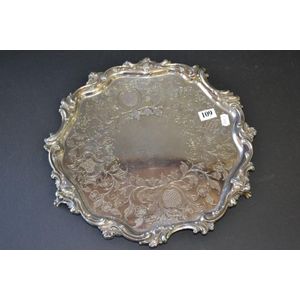Sheffield Armorial Salver with Kangaroo Surmount
A sterling silver armorial salver, 1911, Sheffield, with maker's mark of Henry Wigfull, the circular tray raised upon three small feet, banner style edges with applied scrolls and anethemion motifs, to the centre an engraved armorial with a Welsh motto proclaiming 'Better late than later', and a shield intriguingly surmounted by a kangaroo; hallmarked. Silver weight 490gr. Height 2.5 cm. Diameter 26 cm. (irregular)
You must be a subscriber, and be logged in to view price and dealer details.
Subscribe Now to view actual auction price for this item
When you subscribe, you have the option of setting the currency in which to display prices to $Au, $US, $NZ or Stg.
This item has been sold, and the description, image and price are for reference purposes only.
- Sterling Silver - Sterling silver is a mixture of 92.5% pure silver and 7.5% of another metal, usually copper. Fine silver is 99.9% pure silver, and is relatively soft and the addition of the very small amount of copper gives the metal enough strength and hardness to be worked into jewellery, decorative and household objects.
- Engraving - The method of decorating or creating inscriptions on silver and other metal objects by marking the surface with a sharp instrument such as a diamond point or rotating cutting wheel.
- Hallmarks - A mark stamped on articles of precious metals in Britain, since the 14th century, certifying their purity. It derives its name from the Guild Hall of the Goldsmiths' Company, who recieved its Charter in 1327 giving it the power to assay (test the purity) and mark articles of gold and silver.
The hallmark will consist of several marks, including the:
- silver standard mark, indicating the purity of the metal. Sterling silver is .925 pure silver.
- the city mark indicating the city in which it was assayed eg London, Birmingham, York etc.
- the date mark, usually a letter of the alphabet in a particular font and case,
- a duty mark, indicating whether duty had been paid to the crown, and only in use from 1784 to 1890
The piece may include an additional mark, the maker's mark, although not forming part of the hallmark, will be located in the vicinity of the hallmarks.
Sometimes silver plated items will bear faux hallmarks, often confusing those not familiar with silver markings. - Salver - A plate or tray used for the formal offering of food, drink, letters or visiting cards, usually of silver plate, silver or silver-gilt. Large, heavy, oblong or oval silver salvers evolved into what we know as trays in the 18th century. Small, flat salvers are known as waiters.
- Armorial / Armourial - Bearing a coat of arms. Coats of arms came into general use by feudal lords and knights in in the 12th century, and by the 13th century, arms had spread beyond their initial battlefield use to become a flag or emblem for families in the higher social classes of Europe. They were inherited from one generation to the next. When a family crest is used on individual items of silver or furniture it is an indicator of the aristocratic standing of the family represented.
Armorials were also used to decorate mass produced ceramic souvenir ware by such companies as Goss, Carlton & Shelley, and in these cases the coats of arms displayed were of boroughs and cities.
This item has been included into following indexes:
Visually similar items

Edwardian sterling silver fan bordered salver. Standing on three ball and claw legs. Sheffield 1911. Maker Fordman and Faulkner
Sold by
in
for
You can display prices in $Au, $US, $NZ or Stg.

A Victorian sterling silver salver. Maker Walker & Hall, Sheffield 1896, 507g
Sold by
in
for
You can display prices in $Au, $US, $NZ or Stg.

Heavy Victorian Sheffield plate tray with ornately decorated and shaped border and handles 70 cm long, 50 cm wide
Sold by
in
for
You can display prices in $Au, $US, $NZ or Stg.

Early 19th century Old Sheffield plate rococo tray or waiter
Sold by
in
for
You can display prices in $Au, $US, $NZ or Stg.
